Japan
![]()
This article is about the state of Japan. For the band of the same name, see Japan (band).
Template:Infobox State/Maintenance/TRANSCRIPTION
Template:Infobox State/Maintenance/NAME-German
Japan (Japanese 日本, pronounced as Nihon or Nippon; ![]() ) is a 6852-island East Asian nation in the Pacific Ocean, indirectly bordered by Russia to the north and northwest, North and South Korea to the west, and Taiwan and China to the southwest, and is the fourth-largest island nation in the world by area. The de facto capital and largest urban settlement is Tokyo, which was abolished as a political entity during World War II; de jure, there is a "capital territory" consisting of eight prefectures including Tokyo.
) is a 6852-island East Asian nation in the Pacific Ocean, indirectly bordered by Russia to the north and northwest, North and South Korea to the west, and Taiwan and China to the southwest, and is the fourth-largest island nation in the world by area. The de facto capital and largest urban settlement is Tokyo, which was abolished as a political entity during World War II; de jure, there is a "capital territory" consisting of eight prefectures including Tokyo.
The formation of the Japanese state began in the 5th century under the cultural influence of the Chinese Empire. Since the 16th century, Japan was in contact with the West and rose to become a great power since the 19th century, acquired colonies such as Korea and Taiwan, participated in both world wars and briefly dominated large parts of Southeast and East Asia. Until 1947, the Empire of Japan was a constitutional monarchy based on the monarchical principle, partly on the Prussian model, with the Japanese emperor as head of state. His aggressive expansionist policy in China in the run-up to and during the Second World War (Pacific War) ultimately led to defeat alongside the Axis powers in August 1945. In the Japanese state formed under Douglas MacArthur's occupation government since 1947, the sovereign is the people, and the highest organ of state power is the parliament, both chambers of which have since been directly elected by the people. The emperorship was not abolished, but the emperor as "symbol of the state" was reduced to ceremonial tasks without independent authority in matters of state. Apart from Japan, there is no state in the world whose head of state is an emperor.
Japan is one of the more densely populated countries in Asia and is the eleventh most populous country in the world with approximately 126 million inhabitants. Most of the inhabitants are followers of Shintoism and Buddhism.
Historically the first industrialized nation in Asia, Japan today has a very sophisticated economy and for many years was the world's second largest economic power behind the United States, with which it has been militarily allied since 1952. As a member of the Group of Seven, Japan is one of the largest industrialized nations on earth and part of the OECD. The United Nations Development Programme ranks Japan among the countries with very high human development.
Japanology is concerned with the study and teaching of the language and culture of Japan in its historical development.
Population
→ Main article: Demographics of Japan and Japanese
See also: Society of Japan, Women in Japan and Social Behavior in Japan
The last census in 2010 showed a total population of 128,056,026 in Japan. However, the population has been declining for years, with the Ministry of Internal Affairs and Communications reporting a total population of 126,659,683 on March 31, 2012. By 2050, the population is expected to be 107 million, which would mean Japan would lose 20 million residents by mid-century.
Japanese society is largely homogeneous ethnically and linguistically. The proportion of foreigners in the population was 2 percent in 2014.
The average life expectancy of the Japanese population from 2010 to 2015 was 83.3 years (men: 80.0 years, women: 86.4 years). Only Hong Kong had a higher life expectancy. Japan is thus the independent state with the highest life expectancy in the world.
Current problems in Japanese society are ageing, youth unemployment and a decline in the birth rate. Politically and socially, it seems impossible to allow increased immigration. The median age in Japan in 2015 was 46.3 years, making it the oldest society in the world.
The ten largest cities by population
| Rank | Name | Prefecture | Region | Inhabitants | Metropolitan Region | ExtendedMetropolitan Region |
| 01 | Tokyo | Tokyo | Kantō | 8.949.447 | Kantō/Tokyo | 36.923.193 |
| 02 | Yokohama | Kanagawa | Kantō | 3.689.603 | Kantō/Tokyo | 36.923.193 |
| 03 | Osaka | Osaka | Kinki | 2.666.371 | Kinki/Keihanshin | 19.341.976 |
| 04 | Nagoya | Aichi | Chūbu/Tōkai | 2.263.907 | Chūkyō | 09.107.414 |
| 05 | Sapporo | Hokkaidō | Hokkaidō | 1.914.434 | Sapporo | 02.584.880 |
| 06 | Kōbe | Hyōgo | Kinki | 1.544.873 | Kinki/Keihanshin | 19.341.976 |
| 07 | Kyōto | Kyōto | Kinki | 1.474.473 | Kinki/Keihanshin | 19.341.976 |
| 08 | Fukuoka | Fukuoka | Kyūshū | 1.463.826 | Kitakyūshū-Fukuoka | 05.515.427 |
| 09 | Kawasaki | Kanagawa | Kantō | 1.425.678 | Kantō/Tokyo | 36.923.193 |
| 10 | Saitama | Saitama | Kantō | 1.222.910 | Kantō/Tokyo | 36.923.193 |
Census 2010
See also: List of cities in Japan
Minorities
- Chinese immigrants and Koreans living in Japan.
- The indigenous Ainu minority on the northern island of Hokkaidō now numbers only a few tens of thousands.
- The Buraku (also: Burakumin) are ethnic Japanese whose ancestors practiced impure professions according to Shintoist and Buddhist beliefs and who are therefore still socially excluded today.
- The Ryūkyū peoples, numerically Japan's largest minority, who historically formed an independent empire with its own culture and language.
- Another minority are the Dekasegi, Japanese-born South Americans, mostly Japanese Brazilians who have immigrated back to the land of their ancestors.
- Japan also has a large number of migrant workers from the member states of the Arab League, India and countries in Southeast Asia.
Language and writing
→ Main articles: Japanese language and Japanese script
The national language is Japanese and is spoken by almost the entire population and most minorities. Numerous regional dialects exist. English is the most commonly taught foreign language at school, but it is often criticized that Japanese English classes focus too much on passing the TOEIC test and teach insufficient communication skills. The second most common foreign language is Chinese.
In addition to Chinese characters (kanji), the Japanese language uses two syllabic writing systems of its own (hiragana and katakana), which are derived from Chinese characters. Place names on street signs, train stations and the like are usually signposted in kanji and in Latin transliteration (Rōmaji).
Minority languages of autochthonous peoples in Japan are the non-Japanese-related Ainu in the northern part of the island of Hokkaido and the Ryūkyū languages on the islands of the same name, which are related to Japanese but form a distinct group.
Religion
→ Main article: Religion in Japan
Several religious faiths have always coexisted in Japan. The most important are the Shintō, which derives from the Japanese original religion, and Buddhism, which reached Japan in the 5th or 6th century. Today, over 80% of Japanese people belong to both major religions at the same time, hence the basic religious attitude in Japan is called syncretic.
Shintō (Eng. Way of the Kami) - often also referred to as Shintoism - is the belief in the native gods of Japan, who can embody forces of nature, but also deified ancestors. Shintō is a polytheistic religion with no founder and no set doctrines, and is therefore based on a different concept of religion than the monotheistic scriptural religions. Also, afterlife and moral concepts are not clearly elaborated and are heavily influenced by Buddhism or Chinese concepts. Basically, the Shintō is a juxtaposition of local traditions with a common ritual core. Many directions of the Shintō, however, invoke the myths of antiquity. At the center of these is the sun goddess Amaterasu, from whom the family dynasty of the Japanese Tennō derives.
Japanese Buddhism is divided into many different sects (schools, directions), almost all of which belong to Mahayana Buddhism. Among the best known Buddhist directions in Japan are Zen Buddhism, Amitabha Buddhism and Nichiren Buddhism. In the religion of Japan, there are also Chinese influences through Daoism and Confucianism, which have been absorbed and integrated by Shintō and Buddhism.
Christianity played a certain role in Japan's history, especially in the 16th and 17th centuries, but today it occupies only a marginal position.
An important element is represented by the "new religions", which have been spreading more and more since the middle of the 19th century and often propagate an idiosyncratic mixture of Shintō, Buddhism and other world religions. Since the Second World War, there has been a particularly high degree of religious tolerance towards these directions, so that at present around 300 such religious communities are officially listed.
Health
Erwin Bälz and Julius Scriba are regarded as the founders of modern western medicine in Japan.
Japan is one of the countries that provide universal health care for their citizens. In Japan, every resident must be insured by law. Health services are provided either by regional or national public hospitals or by private hospitals and clinics. Patients have universal access to any facility, although hospitals tend to charge higher fees for those without a referral. Public health insurance covers costs for most citizens, paying 70% or more for every care and drug prescribed. Patients are responsible for the rest. The portion paid privately is based on the person's disposable income and can be a maximum of 30%. Private supplementary health insurance is only available to cover co-payments or non-covered costs and usually provides a fixed payment per day in hospital. Many health insurance policies in Japan are through the employer. In 2015, Japan spent 10.9% of its economic output on the health care system, of which 84.1% was government funded. The biggest problem facing the Japanese healthcare system is future financing, as costs are expected to rise sharply as society continues to age.
Japan performs excellently in international comparisons of various health indicators. On average, Japanese people had a life expectancy of 84.0 years in 2016. Women had a life expectancy of 87.1 years and men had a life expectancy of 81.0 years. Since the year 1960, the average life expectancy has increased by more than 16 years (Universal Health Insurance has existed since 1961). Japan had one of the lowest proportions of overweight persons among industrialized countries. Infant and maternal mortality rates are very low by international standards and less than 0.1% of the population is HIV positive. In contrast, the Japanese health care system is considered less efficient with regard to mental illness. The country has one of the highest suicide rates in the world and despite initiated reforms, Japanese psychiatric hospitals and mental health facilities use outdated methods in dealing with patients.
| Period | Life expectancy in years | Period | Life expectancy in years |
| 1950–1955 | 62,8 | 1985–1990 | 78,5 |
| 1955–1960 | 66,4 | 1990–1995 | 79,4 |
| 1960–1965 | 69,2 | 1995–2000 | 80,5 |
| 1965–1970 | 71,4 | 2000–2005 | 81,8 |
| 1970–1975 | 73,3 | 2005–2010 | 82,7 |
| 1975–1980 | 75,4 | 2010–2015 | 83,3 |
| 1980–1985 | 77,0 | 2015–2020 | 84,4 |
Source: UN

Population development (million)

Japan is the oldest society in the world
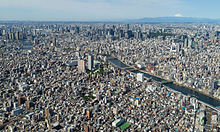
The Tokyo Metropolitan Area is the most populous metropolitan area in the world.
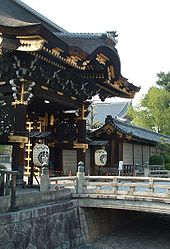
Gate to the Nishi-Honganji, Kyōto
Politics
→ Main article: Political system of Japan
Japan, under the 1947 Constitution, is a parliamentary democracy with the Emperor of Japan (Tennō) as the "symbol of the state and of the unity of the people" with the ceremonial duties of a head of state (subject to the approval of the government, Article 7); his position in the state "derives from the will of the people, with whom sovereign power rests." (Article 1). The legislative branch consists of a bicameral Parliament; the more important House of Commons is re-elected at least every four years. The executive branch is formed by the cabinet headed by the prime minister, who is appointed by both houses of parliament, or by the lower house in case of conflict. The judiciary is headed by the Supreme Court, whose judges are appointed by the cabinet and confirmed by the people. Japan's party system has been dominated by two major parties, the Liberal Democratic Party and the Democratic Party, from the late 1990s onwards, with the latter having been a close second or no longer the strongest party in some elections since it came to power; and since 2017, following party splits and unions including. including with the national conservative-economic liberal Ishin no Tō to form the Democratic Progressive Party, it had splintered into the more left-liberal Constitutional Democratic Party, the more conservative People's Democratic Party, and the national conservative-economic liberal Party of Hope. Since 2020, the majority of the former Democratic Progressive Party's members have consolidated into the Constitutional Democratic Party. In addition, several smaller parties exist at the national level, the largest of which are the Kōmeitō, which governs with the Liberal Democrats, the Communist Party of Japan, and the national conservative-regionalist Nippon Ishin no Kai.
Tennō (Emperor)
→ Main article: Tennō and Japanese Imperial Family
The "symbol of the state and the unity of the Japanese people" is Naruhito, the 126th Tennō (Engl.: emperor, literally "ruler (sent) from heaven"). Legally, he is not considered head of state and sovereign power rests solely with the people. His grandfather Hirohito, the Shōwa-Tennō, rejected the divinity (arahitogami) of Japanese emperors when Japan surrendered in 1945. The 1946 constitution does not give the emperor direct policy-making power; in modern Japan his office is ceremonial. He appoints the prime minister, elected by both parliaments, and the president of the supreme court; he promulgates laws and convenes parliament. He is also the chief priest of the Shintō.
Executive
The executive branch of the Japanese central government, also called the central government (中央政府, chūō seifu), consists of the Japanese Cabinet led by the Prime Minister and the subordinate ministries and assigned agencies. The post of Prime Minister has been held by Yoshihide Suga since September 2020.
The Cabinet is responsible to Parliament. The chief executive, the prime minister, is elected by the upper and lower houses and then appointed by the Tennō. In the event of a conflict, the vote of the lower house prevails. Only members of either the upper or lower house can be elected prime minister. The prime minister appoints (and dismisses) the ministers of his cabinet, the majority of whom must also be members of the upper or lower house. Following the experience of Japanese militarism, the constitution also stipulates that the prime minister and all his ministers must be civilians.
Other rules are not laid down in the constitution, but they are in line with political tradition. In the LDP, for example, the seniority principle applied; ministerial posts are not only awarded according to competence, but serve to reward long-serving members of parliament. The heads of the factions regulate the allocation behind the scenes. Factions are groups of MPs centred around a veteran and influential MP. The factions support their members with much-needed funding for the election campaign, and in return the leader of the faction can rely on the votes of his or her faction in votes in parliament and within the LDP faction.
The post of prime minister is traditionally held by the leader of the strongest party in the lower house. Since this has been the LDP for decades, the election of the LDP leader has de facto decided the succession since 1955; individual interruptions were the years 1993 to 1996 and 2009 to 2012, when the LDP did not provide the head of government.
See also: List of Prime Ministers of Japan
Legislative
The Japanese Parliament (Kokkai, "National Assembly") is the highest organ of state power and the only legislative body in Japan. It is divided into the Senate (Sangiin, "Chamber of Councillors") as the upper house and the House of Representatives (Shūgiin, roughly "Mass Consultative Chamber", also House of Representatives) as the lower house. Both chambers are directly elected. In the election of the prime minister, the budget and the ratification of international treaties, the will of the lower house has in principle priority, in legislation the consent of both chambers or a two-thirds majority in the lower house is required, in particular personnel nominations of the government and constitutional amendment proposals require in any case the consent of both houses of parliament.
There are only 710 MPs in parliament since reforms from 2017 and 2018: 465 in the lower house and 245 in the upper house. Of the 465 seats in the House of Representatives, 289 are elected in single-mandate constituencies under the first-past-the-post system and 176 in 11 regional multi-mandate constituencies (regional "blocs") under proportional representation; of the 245 seats in the Senate, 146 are elected by single non-transferable vote in 45 single-mandate and multi-mandate constituencies, 43 of which are congruent with prefectures and two of which include two prefectures each; 96 are elected by proportional representation with preferential voting in a nationwide constituency. Passive suffrage for the House of Representatives is granted to all men and women who have reached the age of 25; in the upper house, they must have reached the age of 30. Since 2016, all Japanese men and women who have reached the age of 18 are actively eligible to vote. Women's suffrage was introduced at the national level in 1945. In the Empire, the movement for women's suffrage had failed at the Diet: after several unsuccessful legislative initiatives without government support, the Hamaguchi Cabinet introduced a bill for the first women's suffrage at the subnational level in 1931 after controversial discussions among the bourgeois parties; the bill was also passed by the House of Representatives, but was eventually blocked by the Diet. It was only after the defeat of Japan and occupation by the United States in 1945 that previous political restrictions on women were lifted and women's suffrage and passive suffrage were introduced: December 12, 1945 for the Lower House, February 24, 1947 for the Upper House. Thus universal suffrage was part of the democratic constitution dating back to the Occupation. Sixty-seven per cent of women went to the polls on 10 April 1946 and 39 women were elected. By 1952, the legal foundations for women's equality in political, social and economic terms were in place, but little progress had been made since then in challenging male prerogatives in government.
The electoral terms of the two Houses are not automatically synchronised: The House of Commons has a maximum term of four years, but it has completed this only once in post-war history; as a rule, House of Commons elections are held before this if the cabinet dissolves the chamber, which it is entitled to do at any time under the prevailing constitutional interpretation, or is forced to do after a vote of no confidence in the cabinet by the House of Commons if it does not wish to resign. The House of Lords has a fixed term and cannot be dissolved: every three years, half of the MPs are elected on a staggered basis for a six-year term.
After the Meiji Constitution of 1889, the Diet was created on the British and Prussian model. It consisted of the House of Representatives as the lower house and the House of Lords (Kizokuin) as the upper house, and first convened on November 29, 1890. The Mansion House included members of the nobility (Kazoku) and members appointed by the Tennō. The two houses of parliament had absolute equality in most matters, and each could block a bill. The 1947 constitution abolished the House of Lords and replaced it with the elected Sangiin; the Diet became the present National Assembly with a primacy of the House of Representatives (Shūgiin no yūetsu, 衆議院の優越) in crucial matters. Since then, the Prime Minister has been elected by Parliament and must be a member of it. Most prime ministers of the Empire belonged to the House of Lords or not to Parliament at all, only three were members of the House of Representatives. In contrast, all prime ministers since 1947 have come from the House of Commons.
The continued division into upper and lower houses was one of the few significant departures of the adopted constitution from the occupation authorities' specification; the SCAP draft constitution had provided for a unicameral parliament.
Judiciary
Under the constitution, the judiciary is independent of the other two branches. At the top is the Supreme Court (saikō-saibansho). It consists of a chief justice appointed by the Tennō on the recommendation of the cabinet, and 14 chief justices appointed for 10-year terms by the cabinet and periodically legitimized by popular vote. Their office is renewable. Their primary function is to review laws and regulations for constitutionality; only in exceptional cases do they directly intervene in government affairs.
The Supreme Court has the right to review lower court rulings and issues final judgments. Its decisions are the only ones that have a direct influence on the subsequent interpretation of the laws. Japan has a simple system of courts, so there are no separate administrative or labour courts, for example, as in Germany. Below the Supreme Court, the courts are divided into eight high courts (kōtō-), 50 district courts (chihō-) and over 400 simple courts (kan'i-saibansho), in addition to 50 family courts (katei-saibansho).
Parties
Japan has a pluralistic multi-party system in the post-war period with one dominant party, the Liberal Democratic Party (LDP), which has been in permanent government since its founding in 1955 with only two interruptions so far (1993-1994 and 2009-2012).
In the 1990s, the party system was upended when, on the one hand, many LDP members left the party and founded new parties and, on the other hand, the Socialist Party of Japan (SPJ), which until then had still been the largest opposition party, lost further ground and then shrank to a minor party during a (initially still grand) coalition with the LDP. After numerous party formations, the Democratic Party became a rallying point for the opposition. In 2009 it finally succeeded in taking the lower house majority and the leadership of the government, but it quickly lost popularity and already in 2010 the upper house majority. In 2012, she was voted out again in a landslide. Already during and after her time in government, numerous MPs left the party, followed later by party splits and unions.
The largest opposition parties are (as of September 2020) the left-liberal Constitutional Democratic Party and the more conservative People's Democratic Party. Other opposition parties formed during the disintegration of the Democratic Party include the more conservative People's Democratic Party, the more economically liberal Kibō no Tō ("Party of Hope"), and the national conservative-regionalist Nippon Ishin no Kai, which brings together former Democrats and Liberal Democrats. In addition, Ichirō Ozawa's Liberal Party (formerly Nippon Mirai no Tō and Seikatsu no Tō), which cooperated with the Social Democrats, existed from 2012 to 2019. In addition, there are three reasonably continuous parties, two larger ones, the Communist Party of Japan (CPJ), which has consistently been in opposition, and the Kōmeitō, the political arm of the Buddhist organization Sōka Gakkai, which has been part of the LDP's governing coalition since 1999, and the now very small Social Democratic Party (SDP), the successor to the SPJ.
The parties currently represented in parliament are:
- the Liberal Democratic Party (自由民主党, Jiyū Minshutō, LDP),
- the Constitutional Democratic Party (立憲民主党, Rikken Minshutō, KDP, The Constitutional Democratic Party of Japan, CDP),
- the Kōmeitō (公明党, Kōmeitō, "Justice Party"),
- the Communist Party of Japan (日本共産党, Nihon Kyōsantō, KPJ),
- the Nippon Ishin no Kai (日本維新の会, "Assembly for the Renewal/Restoration of Japan"),
- the People's Democratic Party (国民民主党, DVP, Democratic Party For the People; DPFP),
- the Social Democratic Party (社会民主党, Shakai Minshutō, SDP),
- the Reiwa Shinsengumi (れいわ新選組)
- the NHK kara Kokumin o Mamoru Tō (NHKから国民を守る党, "Party for the Protection of Citizens from NHK"),
- the Party of Hope (希望の党, Kibō no Tō),
- the Okinawa Shakai Taishūtō (沖縄社会大衆党, "Okinawa Mass Socialist Party").
- Team Shiga (チーム滋賀).
Government funding of political parties in Japan is among the highest in the world. Under the 1994 Law on Party Financing, parties receive government subsidies of 250 yen per inhabitant (according to the current census) regardless of voter turnout. The distribution is based on the number of their deputies in parliament, divided by the total number in both houses combined, and on their vote shares in lower house and upper house elections. The latter are weighted according to the following key:
- the direct vote in the last House of Commons election to a quarter,
- the proportional votes from the last House of Commons election to a quarter,
- the direct votes of the last two elections to the House of Lords at one-eighth each,
- the proportional votes of the last two elections to the House of Lords, one-eighth each.
Annually, the state pays out a total of about 32 billion yen (2010: about 280 million euros) to the parties. The cut-off date for the assessment of annual party funding is usually 1 January.
Constitution
→ Main article: Constitution of the State of Japan
The current Japanese Constitution was promulgated on 3 November 1946 and came into force on 3 May 1947. In it, the Japanese people pledge themselves to the ideals of peace and democratic order. The constitution was drafted by the then American occupation government under General Douglas MacArthur and has not been amended since. An amendment would require the approval of two-thirds majorities in both houses of parliament and of the people in a referendum.
Article 9(1) of the Constitution rejects war as a sovereign right, and the threat of military force as a means of international conflict resolution is also prohibited. Paragraph 2 is particularly explosive, as it prohibits Japan from maintaining a military. Japan's Self-Defense Forces, and in particular its overseas deployments in Iraq and the Indian Ocean in support of NATO operations in Afghanistan, are therefore highly controversial. The LDP's draft constitutional amendment proposes to change Article 9. It explicitly emphasizes that the military should continue to serve only for self-defense, but also to secure international peace and security. In addition, the draft declares the Tennō to be the head of state.
Furthermore, the inviolability of human rights is emphasised. The draft of the new version also contains a number of other individual rights that have not been listed so far, including respectful treatment of disabled persons and victims of crime, as well as protection of personal data.
The Tennō has a purely representative function under the Constitution. The supreme sovereign under the Constitution is the people, represented by the Parliament. The parliament elects the prime minister, who appoints his cabinet.
Political indices
| Political indices published by non-governmental organisations | ||||
| Index name | Index value | Global rank | Interpretation aid | Year |
| Fragile States Index | 32.3 from 120 | 158 from 178 | Stability of the country: very stable | 2020 |
| Democracy Index | 8,13 from 10 | 21 from 167 | Full democracy | 2020 |
| Freedom in the World Index | 96 from 100 | - — | Freedom status: free | 2020 |
| Press freedom ranking | 28.88 from 100 | 67 from 180 | Identifiable problems for press freedom | 2021 |
| Corruption Perception Index (CPI) | 74 from 100 | 19 from 180 | 0 = very corrupt / 100 = very clean | 2020 |
Domestic policy
The Liberal Democratic Party (LDP) and Kōmeitō have formed the government since 2012. They have had a two-thirds majority in the Lower House since 2012, and a majority in the Upper House since the 2013 election. In addition to Prime Minister Yoshihide Suga, the incumbent cabinet includes Tarō Asō as Deputy Prime Minister and Finance Minister, Toshimitsu Motegi as Foreign Minister, and Katsunobu Katō as Chief Cabinet Secretary. Since the 2019 Sangiin election, the LDP no longer has an absolute majority in both chambers of the National Diet, so it is again mathematically dependent on a coalition partner for legislation.
Suga's government intends to continue Shinzō Abe's economic policies of expansionary monetary policy, increased government investment, and the announcement of structural reforms (the "three arrows" of "Abenomics"). In terms of security policy, Abe's government strengthened the U.S.-style Security Council in 2014, loosened previous restrictive guidelines on military exports, and has legislated a decided expansion of the interpretation of Article 9 of the Constitution to include collective defense.
In September 2018, the LDP chairman election was held by rotation, with incumbent Shinzō Abe clearly prevailing over former defense minister Shigeru Ishiba. Numerous prefectural and local elections were held in 2019, many in the unified regional elections in April. In the same year, a national parliamentary election was held with the upper house election in the summer of 2019. In the September 2020 LDP chairman election held as a result of Abe's resignation, then-Chief Cabinet Secretary Yoshihide Suga prevailed over Fumio Kishida and Shigeru Ishiba.
The largest opposition party at the national level is currently Yukio Edano's Constitutional Democratic Party, following multiple splits between the Democratic Party and its successors.
Foreign Policy
→ Main article: Foreign policy of Japan
The main points of Japan's post-World War II foreign policy are a firm commitment to the United States, checkbook diplomacy, and a constitutional renunciation of military aggression.
The Kuril Islands lying north of Japan and the southern part of Sakhalin Island (the former prefecture (-chō) of Karafuto) have de facto belonged to the Soviet Union (from 1991, the successor state of Russia) since 1945, after Japan ceded the territories in the San Francisco Peace Treaty, although the Soviet Union did not sign the treaty. However, the southern Kuril Islands closest offshore from Hokkaidō Island are not considered part of the ceded Kuril Islands by Japan, and are claimed as "Northern Territories" as part of HokkaiPrefecture (-dō)[dō]. This Kuril Islands conflict is an ongoing problem in Japanese-Russian relations and an obstacle to a peace treaty.
The small archipelago of Takeshima (kor. Dokdo) is administered by South Korea and claimed by Japan after belonging to Japan for about 40 years during the period of Japanese imperialism. In the spring of 2005, the introduction of a Takeshima Day in ShimanePrefecture (-ken) again provoked anger among the South Korean population.
In addition to the Republic of China and the People's Republic of China, Japan also has claims to the Senkaku Islands (Chinese: Diaoyu). Raw materials are suspected to exist in the vicinity of the islands.
Relations with many Asian states - especially with the People's Republic of China, South Korea and North Korea - remain strained, primarily because of a missed reappraisal of imperialist history in the first half of the 20th century. However, the close economic ties and the world's interest in peace in the region make warlike conflicts unlikely; instead, political crises flare up again and again.
In accordance with its constitution, Japan has long stayed out of all international armed conflicts, instead promoting a multilateral trade policy based on free trade. Japan's first overseas military deployments were in the early 1990s, with minesweepers in the Persian Gulf for the coalition in the Second Gulf War and participation in UN missions beginning with UNTAC in Cambodia. In 1992, the parliament passed the PKO Cooperation Act (PKO協力法, pī-kei-ō-kyōryoku-hō) as a basis for participation in peacekeeping missions (PKO), which, given the opposition majority in the Senate at the time (Nejire Kokkai, in this context also PKO Kokkai, PKO国会) was negotiated between the ruling Liberal Democrats and parts of the opposition (notably Democratic Socialists and Kōmeitō), but against staunch opposition from the Socialists, then the largest opposition party, and the Communists. In the aftermath of the Cambodia mission, the basic attitude of the Japanese public towards foreign missions shifted, so that participation in UN peacekeeping missions is now widely accepted, and was later also supported by the majority of the Socialists when they participated in several governments from 1993 onwards.
Socially controversial, on the other hand, remains participation in missions in active conflict areas, such as within the framework of the Alliance: In January 2004, based on the Antiterrorism Act passed by parliament in 2001 and the Iraq Reconstruction Act passed in 2003, the cabinet decided to send Japanese soldiers to a de facto active conflict, namely to Iraq as part of the coalition of the willing after the Third Gulf War, but according to government interpretation explicitly to "no combat zone" (hi-sentō chiiki, 非戦闘地域); the law prohibits deployment in a combat zone. While then Liberal Democratic Prime Minister Jun'ichirō Koizumi saw this as evidence of close friendly relations with the United States, many Japanese consider it a breach of the constitution. However, these soldiers were constitutionally unarmed and were only used for infrastructure reconstruction. In June 2006, Koizumi declared the deployment complete, after which the troops began their withdrawal from Iraq on June 25.
Japan participated indirectly in Operation Enduring Freedom from 2001 onwards with a refuelling mission in the Indian Ocean, which first had to be interrupted for several months in 2007 when the oppositional Senate majority led by the Democratic Party prevented a timely extension of the Anti-Terrorism Act, but was then initially resumed on the basis of a new Anti-Terrorism Act. In January 2010, the mission was terminated under the Democratic-led government when the temporary reauthorization of the anti-terrorism law also expired.
The relationship between the European Union and Japan is based on a political declaration of 1991 which sets out principles and objectives for cooperation. The declaration was expanded by an "EU-Japan Action Plan" in 2001. It forms the basis for enhanced cooperation in the areas of foreign policy, the economy, the monetary and financial system, development aid and communications technology.
The EU and Japan are important trading partners for each other. Together, they generate 40 percent of the world's gross national income. On 6 July 2017, EU Council President Donald Tusk and EU Commission President Jean-Claude Juncker agreed with Japanese Prime Minister Shinzo Abe to conclude JEFTA, the EU's largest bilateral free trade and investment protection agreement to date.
There is a great deal of agreement between Japan and the EU on key issues such as climate protection and security policy. Alongside the fight against terrorism, the non-proliferation of weapons of mass destruction is an important issue. Together they are appealing to North Korea to halt its nuclear programme. In the area of climate protection, Japan and the EU want to play a pioneering role in drawing up a successor to the Kyoto Protocol and reduce CO2 emissions by 50 percent by the middle of the century.
Since 2014, the country has also had observer status in the Community of Portuguese-Speaking Countries (CPLP). The background is the historical Japanese-Portuguese relations and the Brazilian-Japanese relations, especially the mutual Brazilian-Japanese emigration.
Japan has been on the list of Major non-NATO ally since 1989, making it one of the United States' closest diplomatic, military and strategic partners outside NATO.
| Memberships in international organizations (selection) | |||||
| UN system | Global organizations | Regional organizations | |||
| Organization | Accession year | Organization | Accession year | Organization | Accession year |
| United Nations | 1956 | World Trade Organization | 1995 | APEC | 1989 |
| World Bank/IBRD (7.86% share) | 1952 | OECD | 1964 | Council of Europe (observer) | 1996 |
| International Monetary Fund (6.12% share) | 1952 | Group of Seven | 1975 | Asian Development Bank | 1966 |
| UNESCO | 1951 | Interpol | 1952 | African Development Bank (non-regional) | 1983 |
| Food and Agriculture Organization | 1951 | International Criminal Court | 2007 | ASEAN Plus Three/East Asia Summit | 1997/2005 |
| International Maritime Organisation | 1958 | International Organization for Migration | 1993 | Asia Cooperation Dialogue | 2002 |
Military
→ Main article: Self-Defense Forces
In Article 9 of the Japanese Constitution, Japan renounces the right of sovereign states to wage war, even a defensive one. This clause is unique in the world; it was included after Japan's defeat in World War II to prevent renewed militaristic aggression. In the process, however, the interpretation of Article 9 has been gradually expanded: in the 1950s to rearmament, in the 1990s to participation in foreign operations, in the 21st century to the acquisition of certain military equipment. century to the acquisition of certain military equipment (such as helicopter carriers) that could be considered offensive weapons-and thus a violation of Article 9's prohibition on the potential for war (senryoku)-and partial aspects of collective defense, with the Cabinet Legislative Office determining as early as 2001 that collective defense as such was not covered by the Constitution. Various amendments to the Japanese constitution had already been discussed since its adoption, particularly to Article 9. Against the background of the growing military power of the People's Republic of China, the right-wing conservative government under Prime Minister Shinzō Abe decided in July 2014 to reinterpret the constitution and thus introduce a new military doctrine. Following a successful parliamentary vote in September 2015, Japan will henceforth be allowed to use the right of "collective self-defence" and fight alongside allies in conflicts, even if it is not directly attacked. The change came about despite fierce protests from the population and massive opposition from the opposition.
During the occupation, a police reserve was formed when the Korean War broke out in the former colony and many of the US troops stationed in Japan withdrew there. With sovereignty in 1953, the Japan Self-Defense Forces (JSDF; English for jieitai, "self-defense forces") was formed from this police reserve a year later, divided into land, sea, and air forces. The word gun (軍, "army", "armed forces"; explicitly forbidden by Article 9) is generally omitted from the designation - in contrast to rikugun ("land forces"=heer/army) and kaigun ("sea forces"=navy) of the Empire. At the same time as the peace treaty, a military alliance with the former wartime adversary, the United States, was concluded, which was reissued in 1960 in the form of the Treaty of Mutual Cooperation and Security, despite a wave of protests from left-wing parties, students and trade unions, and has since been automatically renewed as long as it is not terminated. In 2007, Japan signed a security agreement with Australia, the second country ever to do so. Both countries want to intensify their cooperation in border control, the fight against terrorism and disaster relief. Joint military maneuvers and intelligence cooperation are also planned. Direct security cooperation with the Republic of Korea, the most important US ally in East Asia alongside Japan, as desired by Washington, has so far failed due to Japan's lack of sense of responsibility for its own history, the territorial dispute and the nationalist sentiments in Korea fanned by this: for example, public protest in Korea prevented the signing of a first bilateral security agreement on the exchange of information in 2012. An agreement actually concluded at the turn of the year 2014/15 on the exchange of intelligence information on the Democratic People's Republic of Korea again does not provide for direct bilateral cooperation, only indirect exchange via US services. The Republic of Korea's armed forces first participated as observers in the regular U.S.-Japan exercise Keen Sword in 2010.
Japan does not have compulsory military service. Japan spent just under 0.9% of its economic output, or $45.4 billion, on its armed forces in 2017, placing it 8th in the world. 1% of economic output was the maximum level of military spending set by cabinet decision in 1976; this ceiling was already formally abolished after the end of the coalition government in 1986 under Yasuhiro Nakasone, but even then it was only symbolically increased by a fraction (initially to 1.007%) and never significantly exceeded. In 2017, Shinzō Abe declared the 1% limit abandoned (but again). In addition, Japan participates in the military presence of the United States on the basis of the SOFA of 1960 with the Omoiyari Yosan (思いやり予算; "sympathy budget") of currently over 200 billion yen (equivalent to about 1.4 billion euros) annually.
Japan ranked 111th out of 155 countries in the Global Militarization Index (GMI) in 2018. According to Global Firepower's ranking (2018), the country has the eighth strongest military capability in the world and the fourth strongest in Asia.
Previous foreign deployments of the Self-Defense Forces have been and are:
- supporting missions
- 1991 with minesweepers in the Persian Gulf for the coalition in the Gulf War
- 2001-2007 and 2008-2010 with refuelling vessels in the Indian Ocean for Operation Enduring Freedom in Afghanistan
- 2004-2008 with air and ground forces mainly for reconstruction in the south of Iraq for the coalition in the Gulf War
- for protection against piracy at sea
- since 2009 off Somalia
- in the framework of United Nations peacekeeping missions
- 1992-1993 UNTAC in Cambodia
- 1993-1995 ONUMUZ in Mozambique
- 1996-2013 UNDOF in the Golan Heights (Syria/Israel)
- 2002-2004 UNTAET/UNMISET in East Timor
- 2007-2011 UNMIN in Nepal
- 2008-2011 UNMIS in Sudan
- 2010-2012 UNMIT in East Timor
- 2010-2013 MINUSTAH in Haiti
- since 2011 UNMISS in South Sudan
- several short-term missions for disaster and refugee relief
On the part of the People's Republic of China, the accusation is often made that a new militarism is emerging in Japan. Historically, these fears are justified by China's great suffering (an estimated 18 million civilian casualties) in the Second Sino-Japanese War. However, Japan has shown no military aggression since World War II and has been an active advocate of nuclear disarmament, while China has caused several conflicts with its neighbors (in the wake of the 1959 Tibet Uprising, 1962 Indo-China Border War, 1969 Ussuri Incident, 1979 Sino-Vietnamese War).
- Indeed, military threat scenarios in Japan primarily see Chinese troops landing on the coast. In 2005, another area of conflict became apparent when Japan first defined the protection of Taiwan as part of its interests.
- A second threat scenario is offered by North Korea, which has already fired missiles over Japanese territory on several occasions and surprised the world public in 2005 by claiming to possess nuclear weapons. In October 2006, the North Korean government attempted to substantiate this claim with a nuclear bomb test. However, it is unclear whether the recorded shock was actually the explosion of a nuclear weapon. Because of this threat, Japan is working closely with the United States to develop a joint missile defense shield.
- The third threat scenario is a terrorist attack, as demonstrated by the attack on the Tokyo subway by the Ōmu-Shinrikyō sect in 1995. Due to the involvement in Iraq, there are fears that Japan could also become a target for Islamist groups, and there have already been indications to this effect.
Japan's then Prime Minister Koizumi reaffirmed on 6 August 2006 that his country would continue its anti-nuclear policy. With prayers, wreath-laying ceremonies and calls for a world free of nuclear weapons, people in Hiroshima remembered the victims of the first atomic bomb dropped 61 years earlier.
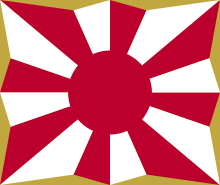
Flag of the Self-Defense Forces
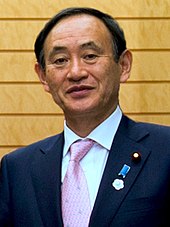
Prime Minister Yoshihide Suga
.jpg)
Emperor Naruhito (2018)
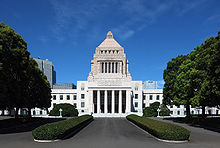
The Japanese Parliament building in Nagatachō, Chiyoda, Tokyo Prefecture.
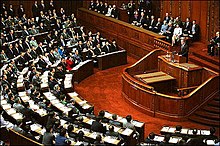
Plenary hall of the House of Representatives
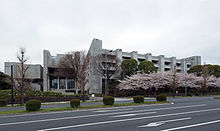
Supreme Court building in Chiyoda
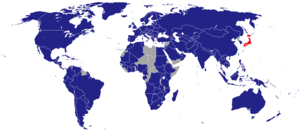
Countries that have embassies from Japan
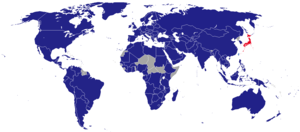
Countries that have embassies in Japan
.jpg)
Ships of the JMSDF: A Takanami class submarine destroyer (left) with the helicopter carrier Izumo
Questions and Answers
Q: What is the name of Japan in Japanese?
A: The name of Japan in Japanese is 日本.
Q: Where is Japan located?
A: Japan is located in East Asia, close to the east coast of Korea, China and Russia. The Pacific Ocean is to the east of Japan and the Sea of Japan is to the west.
Q: What are the four main islands that most people in Japan live on?
A: Most people in Japan live on one of four islands - Honshu, Hokkaido, Kyushu and Shikoku.
Q: How big is Honshu Island?
A: Honshu Island is the 7th largest island in the world.
Q: What city serves as capital for Japan?
A: Tokyo serves as capital for Japan and it's also its biggest city.
Q: How long has the monarchy been ruling over Japan?
A: The monarchy has been ruling over Japan for more than 2,000 years, making it one of oldest monarchies still existing today.
Q: What does "Nihon" or "Nippon" mean when translated from Japanese?
A: When translated from Japanese, "Nihon" or "Nippon" means "the origin of the Sun".
Search within the encyclopedia